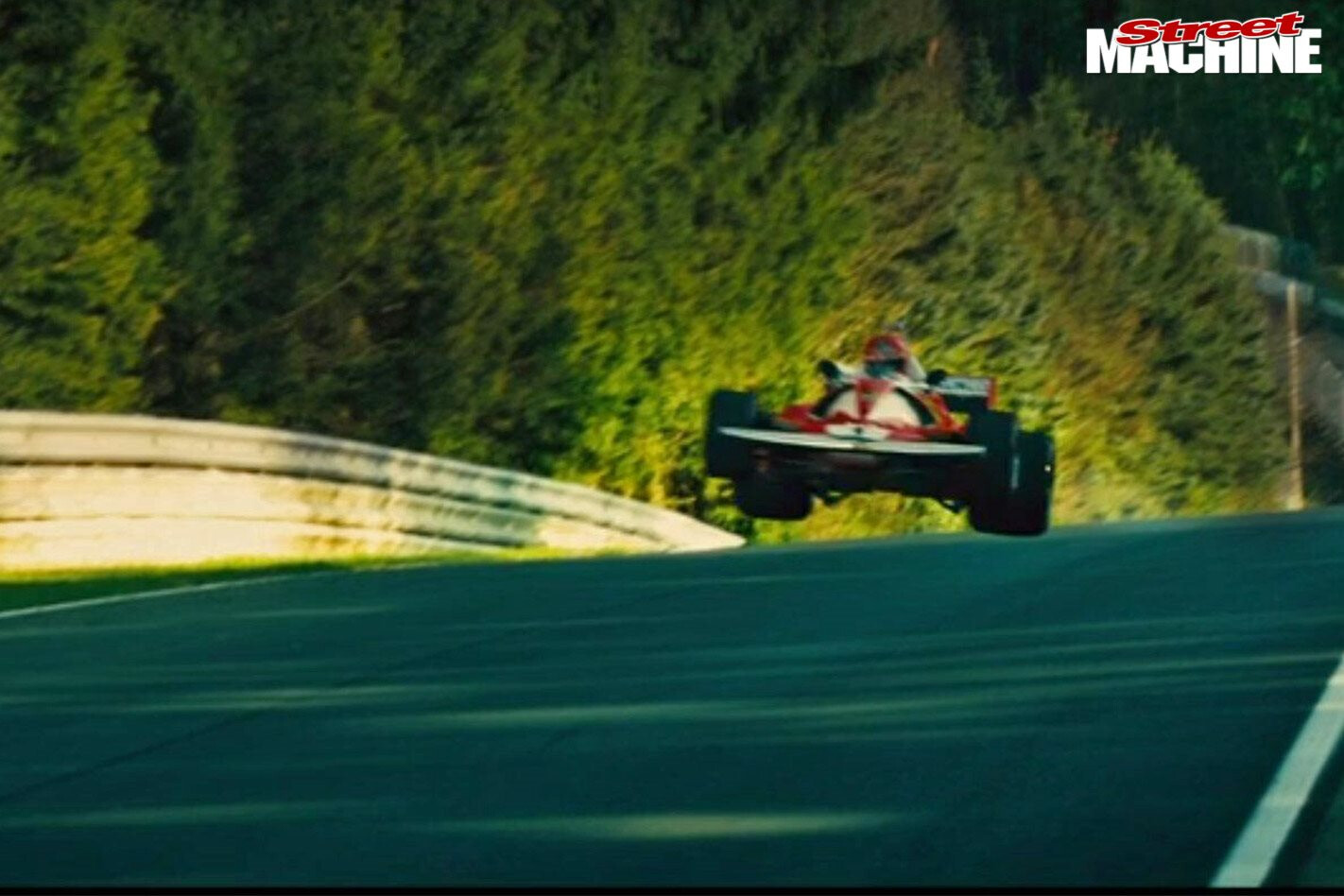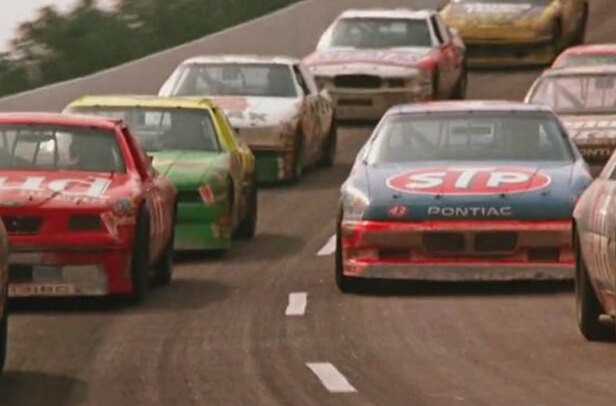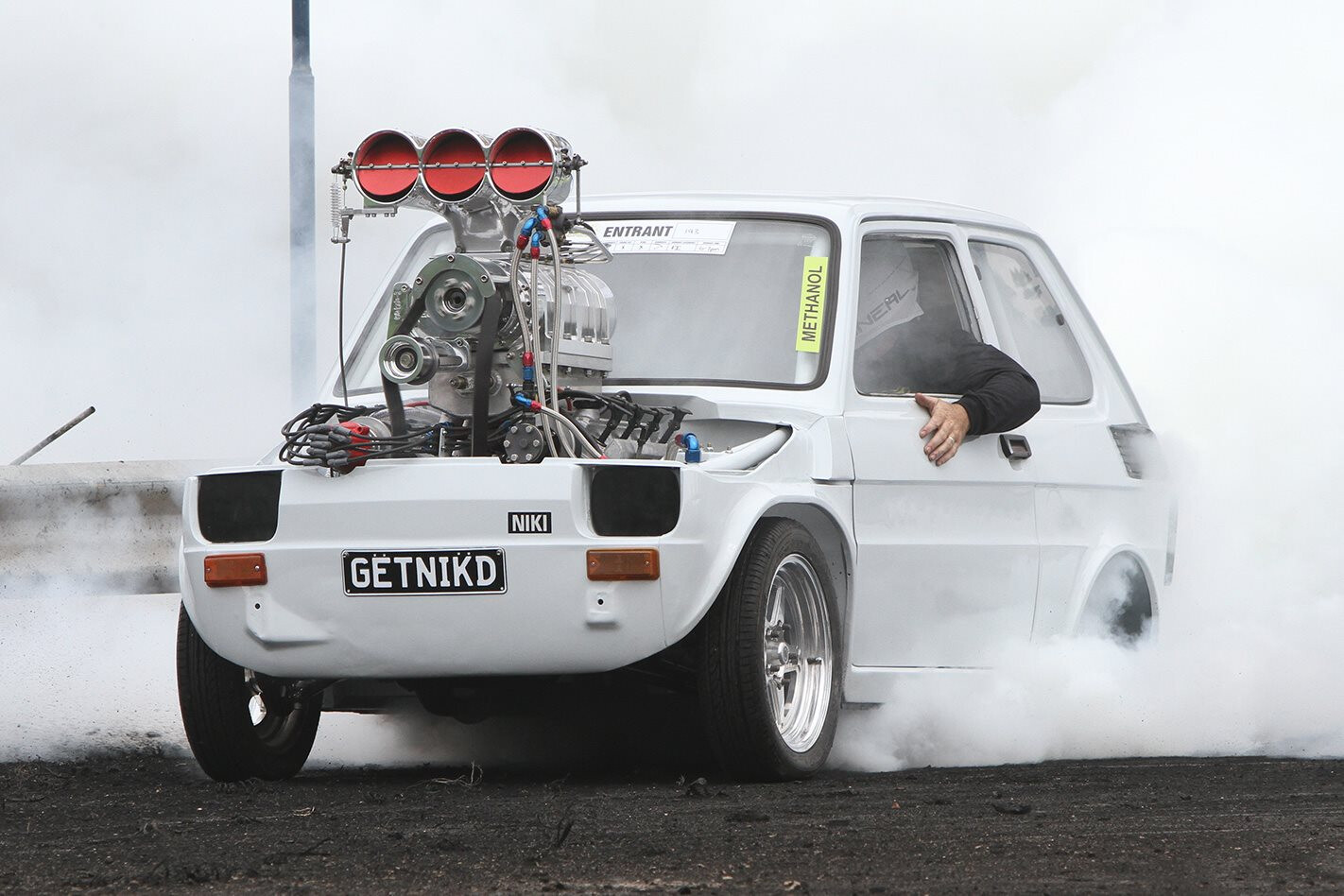FROM its very first images – dark clouds, radio chatter, a concerned eyeball directed towards a brooding sky – it’s clear Rush isn’t going to be your average dumb sports biopic. Ron Howard’s film opens on the 1976 Formula One season; we see James Hunt (Hemsworth) swaggering through the pits like a rock star, along with his arch-rival Niki Lauda (Brühl), whose voiceover provides us the stark statistics of their chosen profession: every season, two racers will die.

It’s moments before Lauda’s famous, life-changing crash at the Nürburgring circuit. Exhausts spit fire, tyres scrabble for grip and ear-splitting engine noise overlays the impeccably recreated launches of the Ferraris, Ligiers and Lotuses. It’s intoxicating, especially for us Gen-Xers that never got to see it, but the car porn is over all too soon.
Howard lets the critical Nürburgring moment hang as we’re whisked back six years prior to follow Hunt and Lauda through their time in Formula Three, battling at the pointy end of the field.
By 1973, both have graduated to Formula One. Hunt’s flamboyant Hesketh team, run by the foppish Lord Hesketh himself, is all wine, lobster, caviar and weed, while Lauda self-funds his way to a seat, leveraging his car set-up skills and playing hardball with the BRM team boss to his advantage.
The following year Lauda is at Ferrari at the behest of former BRM teammate Clay Regazzoni, while Hunt is still fooling around at Hesketh. The next season closes with Lauda taking the championship series and Hesketh running out of money, leaving Hunt without a drive for 1976.
Lauda (Daniel Brühl) asks teammate Clay Regazzoni (Pierfrancesco Favino): “Why am I an asshole? You know by now I’m both quicker than you and better at setting up the car. If you can’t deal with that, then you’re the asshole.”
Hunt and Lauda’s rivalry over the 1976 season is shown in montage format, with the pair trading blows race-by-immaculately-recreated-race. It’s hard to discern what is original footage, what is new footage of old cars or replicas, and what is completely computer-generated, which is exactly as it should be.
We’re then reintroduced to the opening scene: Nürburgring, 1976, with the rain, wet-weather tyres, and the glimpse of a six-wheeled Tyrrell marking the event with a sense of foreboding. Lauda wants the race cancelled, with Hunt goading him and other seemingly cowardly drivers into pushing ahead. The remainder of that race has been oft-documented, and Lauda’s ongoing health issues as a result of his horrific ’76 crash no doubt contributed to his premature death, aged 70, on 20 May 2019.
Lauda’s miraculous, hard-fought recuperation is shown as Hunt grabs championship points. But after a lay-off of only two races, the Austrian returns to the track a changed man, with even more focus on the risk-versus-benefit equation.
Rush ain’t no rom-com, but you’d have to be made of stone not to get deeply absorbed. The mandatory 1970s setting means there is something for everyone to look at, and the score by the prolific Hans Zimmer is one of the best we’ve heard. Howard’s attempt to give Lauda and Hunt depth is also welcome; both men were complex souls with much to lose, but it’s fair to say that some D&M time is probably curtailed in favour of the visuals. As a result, Hunt does come across as a himbo and Lauda as an unstoppable Austrian automaton. In interviews, Lauda himself noted that the drama was exaggerated for effect.
Chris Hemsworth as James Hunt looking pensive before a race. Hunt would famously down liquor and smoke weed before puking his guts up, then win races.
Some points jar, too; screenwriter Peter Morgan’s inexplicable renaming of Nürburgring from ‘The Green Hell’ to ‘The Boneyard’ is one, while Hunt beating up a reporter who criticised Lauda’s new look is another, since the incident never actually happened. But the scene does serve to illustrate Hunt’s genuine respect for Lauda, which the latter reveals was mutual in his closing voiceover, asserting that Hunt was among the very few he liked, fewer he respected and the only person he envied.
James Hunt and Nurse Gemma (Natalie Dormer) appear to be celebrating, but this was Hunt’s pre-race drinks!
VERDICT: 5/5
IN THE words of Lord Hesketh himself: “Ahhhh! What music! They could never have predicted it, those pioneers that invented the automobile. That it would possess us like this, in our imaginations, our dreams. Men love women, but even more than that, men love CARS.” With a steady parade of both – all in context of the story, of course – there’s nothing not to like about Rush. Hunt the Shunt versus Lauda the Rat: Never was there a story like this, nor a dramatisation more befitting.
Lauda’s car gets air at ‘Flugplatz’ on the Nürburgring circuit.
VEHICLES:
1976 McLaren M23D
1976 Ferrari 312 T2
1975 Hesketh 308
1969 Brabham BT28
1973 BRM P160E
1977 Tyrrell P34
1977 Peugeot 504
1971 Lancia 2000 Berlina
1974 Dino 308 GT4
1971 Toyota TA22 Celica
STARS:
Chris Hemsworth
Daniel Brühl
Olivia Wilde
Natalie Dormer
Alistair Petrie
Alexandra Maria Lara
Pierfrancesco Favino
Christian McKay
Already on fire and suffering impact damage, Lauda’s crash was made worse when American Brett Lunger unavoidably ploughed his Surtees TS19 into the Austrian’s burning Ferrari, quickly followed by Harald Ertl’s Hesketh 308D.
DIRECTOR:
Ron Howard
ACTION:
Plenty, both on the race track (some expertly recreated on-track argy-bargy shows James Hunt wasn’t nicknamed ‘Hunt the Shunt’ for nothing) and in Hunt’s hotel rooms!
PLOT:
Chronicles the rivalry between F1 drivers James Hunt and Niki Lauda from the early 1970s through to the close of the 1976 season, where Hunt won the championship but Lauda, against all odds, walked away with his life
AVAILABLE:
DVD, Blu-ray and digital download




Comments